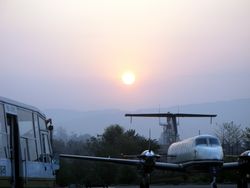
However, as we enter Sunday in Nepal, the clouds broke and flights to Luklastarted again. I am receiving notes from climbers already in Namache. Another normalbeginning to the season.
Luanne Freer, of EverestER put it well in her Blog. This is Luanne's8th season of providing medical services to climbers, Sherpas andporters through EverestER.
Early this morning, bags all packed and ready, we headedto the airport for our flight to Lukla, 2800m where we begin our trekto Everest base camp. Flying in this part of the world is always anadventure – from the crowded and chaotic terminal to the alwaysstressful weighing of the bags (we're set to take off with 220kg, whichis kind of slim for us) to the hurry up and wait of the actual boardingprocess. Then there's the biggest unknown … the weather. Flights toLukla rely not only on skillful pilots and hardy planes, but on mostlyclear skies, since the landing is purely visual, and the landing strip… well … downright scary – an inclined short runway carved into theside of the mountain (see below … I'm sweating already…) Today,for the 3rd day in a row, anxious folks waited in vain for the skies toclear in Lukla. And because of the backlog of the past few days therewasn't a spare seat in the boarding gates.
A few new climbers to highlight.
Wendy Booker, who has MS, is returning after her attempt last year.She is climbing with RMI this time. Over on the north, a very smallteam of Julio Bird, Bill Fischer and 70 year-old Japanese Hoshino Koheiwill be going for the top. This means we will see a 13 year-old and a70 year-old on the same side!
Speaking of the north, China officially closed the border a fewweeks ago and hinted it would reopen around April 10th. This delayedand even caused some expeditions to cancel other climbs. We will seewhen it really opens but this comment from Jantoon Reigersman tells usthe current status. Jantoon is trying to combine cycling, a deep waterdive of 1300m (4265 ft) and his Everest summit for a full 9000mexperience.
Unfortunately, we are still having delays in getting thepermits and due to possible strikes in China, we will not be able tofile any paperwork until March 29th. Now I will have to start figuringout what the alternative plans would be if we cannot get the paperworkin time. Already (even if everything goes perfectly smoothly), enteringTibet on April 1st is very tight and will mean that I cannot take onany delays during the cycling. leaving much later will start making theplanning a lot more complex and there will be a moment where I willhave to decide to skip the cycling and go with the rest of the team.Now it is a game of wait and hope. Patience is not my strongest side,so I will have to start working on some back up plans.
Many of the commercial teams have started to post updates includingAAI, ���ϳԹ��� Consultants and IMG. And a few of the individualclimbers are sharing as well. Look for teams to get to Lukla soon andstart their trek to EBC. It will take about 8 days depending on how theacclimatization process goes.
The trek to base camp is a lifetime event for some people and alwaysa highlight for Everest climbers. There are no paved roads as the routeenters the Sagarmatha National Park. The Park is about 450 square milesand includes Everest, Ama Dablam and many other peaks. It is an UNESCOWorld Heritage Site and the entrance fee is a bargain USD$13.84. About3500 Sherpas call the area home.
The tea houses will be full once again and the local Nepaleseenjoying the business that comes from climbers and trekkers. But withall this popularity, there is a price.
According to Nepal SK 2993, 17000 trekkers employ 14000 porters,2500 guides and staff, 2800 yak owners and 14000 merchandise porters(carrying goods for Sherpa lodge owners and other traders in thetourist region). According to a TED Case Study, four times as much fuelwood is needed to cook a meal for a Western tourist than for a Nepalidue largely to differences in diet.
Many tea houses use yak dung as fuel and others use kerosene.Cutting of wood is mostly prohibited and there are tree farms that willhopefully restore the forests one day. However, overriding all theenvironmental concerns is the simple fact that tourism is now the majoreconomic driver for Nepal. The people of the Khumbu Region know thatprotection of their area will ensure future tourism plus provide afuture for their children. As always, it is about achieving balance.
Tourism is a double-edge sword. Without it, this area would be miredin deep poverty. With it, the struggle to preserve the future is real.However, the Khumbu is a beautiful area with wonderful people. Theircharm touches each person and gives a gift that stays forever.
Climb On!
Alan
Arnette is a speaker, mountaineer and Alzheimer's Advocate. You can read more on his